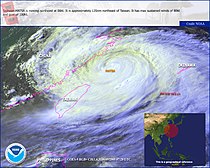
The 2004 Pacific typhoon season was an extremely active season that featured the second-highest ACE ever recorded in a single season, second only to 1997, which featured 29 named storms, nineteen typhoons, and six super typhoons. It was an event in the annual cycle of tropical cyclone formation, in which tropical cyclones form in the western Pacific Ocean. The season ran throughout 2004, though most tropical cyclones typically develop between May and October. The season's first named storm and also the first typhoon, Sudal, developed on April 4, later was reached typhoon status two days later, and became the first super typhoon of the year three days later. The season's last named storm, Noru, dissipated on December 21.

The 2003 Pacific typhoon season was a slightly below average yearlong period of tropical cyclogenesis exhibiting the development of 45 tropical depressions, of which 21 became named storms; of those, 14 became typhoons. Though every month with the exception of February and March featured tropical activity, most storms developed from May through October. During the season, tropical cyclones affected the Philippines, Japan, China, the Korean Peninsula, Indochina, and various islands in the western Pacific.

The 2002 Pacific typhoon season was a slightly above average Pacific typhoon season, producing twenty-six named storms, fifteen becoming typhoons, and eight super typhoons. It had an ACE over 400 units, making it one of the most active seasons worldwide. It was an event in the annual cycle of tropical cyclone formation, in which tropical cyclones form in the western Pacific Ocean. The season ran throughout 2002, though most tropical cyclones typically develop between May and October. The season's first named storm, Tapah, developed on January 11, while the season's last named storm, Pongsona, dissipated on December 11. The season's first typhoon, Mitag, reached typhoon status on March 1, and became the first super typhoon of the year four days later.
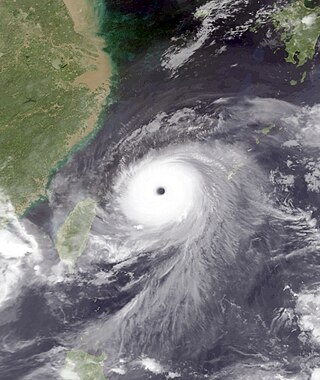
Typhoon Saomai, known in the Philippines as Super Typhoon Juan, was considered the most powerful typhoon on record to strike the east coast of the People's Republic of China. It was the eighth tropical storm, fifth typhoon, and third super typhoon of the 2006 Pacific typhoon season recognized by the Joint Typhoon Warning Center. According to the Japan Meteorological Agency, Saomai was the seventh tropical storm and fifth typhoon of the season. The name "Saomai" was submitted by Vietnam, and is from the Vietnamese word for "morning star", a reference to the planet Venus.

Severe Tropical Storm Bilis, known in the Philippines as Tropical Storm Florita, was a severe tropical storm in July 2006 that caused catastrophic damage to areas of the Philippines, Taiwan, and southeastern China. The word Bilis, submitted by the Philippines, means 'speed' or 'swiftness' in Tagalog.
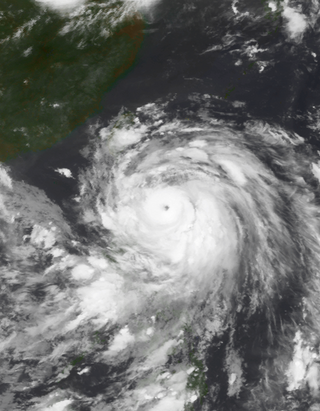
Super Typhoon Kent, known in the Philippines as Typhoon Gening, was a powerful Category 4-equivalent typhoon that formed in late August during the 1995 Pacific typhoon season.
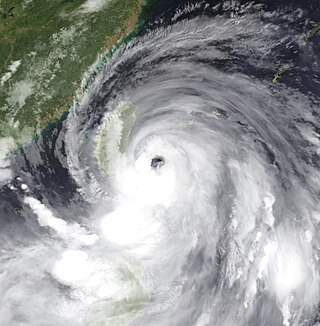
Typhoon Fung-wong, known in the Philippines as Typhoon Igme, was a deadly typhoon in the 2008 Pacific typhoon season which made landfall on Taiwan and China. Typhoon Fung-wong reached peak intensity of a Category 2 typhoon on the Saffir-Simpson Hurricane Scale by the Joint Typhoon Warning Center with peak winds of 95 knots (176 km/h). Damage was extensive in Taiwan, hitting little more than a week later than Typhoon Kalmaegi, but a specific cost is unknown, though later estimated at 541 million.
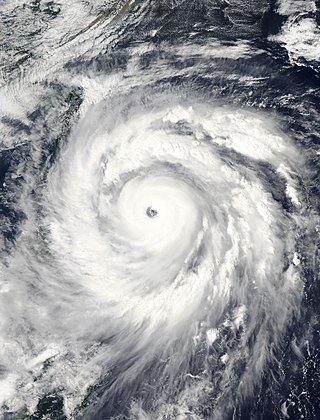
Typhoon Jangmi, known in the Philippines as Super Typhoon Ofel, was the most intense tropical cyclone in the Northwest Pacific Ocean during the 2000s, tied with Nida in 2009, and the most intense tropical cyclone worldwide in 2008. Jangmi, which means rose in Korean, formed in a low pressure area south of Guam on September 22. After undergoing serious consolidating with convective banding, the low pressure area was upgraded to a Joint Typhoon Warning Center late the same data. Undergoing the same process, the storm developed into a tropical storm on September 24. Undergoing rapid deepening on September 26–27, the storm, now a Super Typhoon entered the Philippine Area of Responsibility, and was named Ofel. The next day, Jangmi made impact in Taiwan, thousands were evacuated, rainfall, up to 994mm were recorded, and thousands of acres of farmland were destroyed. Jangmi was significantly weakened as it interacted with Taiwan, as being downgraded to tropical storm status after leaving Taiwan on September 29. After undergoing an extratropical transition, Jangmi became a remnant low on October 1. After slowly moving eastward, until finally dissipating near Iwo Jima on October 5.

Typhoon Wipha, known in the Philippines as Super Typhoon Goring, was the strongest typhoon to threaten the Chinese coastline since Typhoon Saomai in August 2006. Forming out of a tropical disturbance on September 15, 2007, it quickly developed into a tropical storm, and intensified into a typhoon the following day with the appearance of an eye feature. After a period of rapid intensification, Wipha attained its peak intensity on September 18, with winds of 185 km/h (115 mph) and a barometric pressure of 925 mbar (hPa), according to the Japan Meteorological Agency. Later that day, the storm began to weaken as it interacted with the mountainous terrain of Taiwan before brushing the northern edge of the island. Wipha subsequently made landfall near Fuding along the Fujian–Zhejiang provincial border with winds estimated at 185 km/h (115 mph) by the JTWC. Shortly thereafter, the typhoon weakened as it moved inland, weakening to a tropical storm within 18 hours of moving over land.

Typhoon Winnie, known in the Philippines as Typhoon Ibiang, was the most destructive tropical cyclone to impact the Chinese provinces of Zhejiang, Fujian, Jiangsu, and Shandong in 200 years. Originating from an area of low pressure over the Pacific Ocean on August 5, 1997, the system organized into a tropical depression. It headed northwestward, slowly strengthening into a tropical storm on August 9. Intensification became more rapid as conditions became more favorable, and Winnie reached typhoon strength on August 10. On August 12, 1997, Winnie became a Category 5-equivalent super typhoon, with peak 1-minute sustained winds of 160 miles per hour (260 km/h). Winnie then weakened and passed north of Taiwan, before making landfall in Eastern China at Category 1-equivalent typhoon strength on the August 18. Winnie continued northeast over land while weakening, bringing heavy rainfall before dissipating on August 23.

Typhoon Rananim, known in the Philippines as Typhoon Karen, was the strongest typhoon to make landfall on the Chinese province of Zhejiang since 1956. It formed on August 6, 2004, intensifying into a tropical storm on August 8. Rananim gradually intensified, initially moving northward before turning to the northwest and attaining typhoon status. After developing a small eye, the typhoon attained peak winds of 150 km/h (93 mph) as it passed between Taiwan and Okinawa. On August 12, Rananim moved ashore in China, and it dissipated three days later. The name Rananim means "hello" in the Chuukese language.

Typhoon Alex, known in the Philippines as Typhoon Etang, affected the Taiwan, China, and South Korea during July 1987. Typhoon Alex developed from the monsoon trough that spawned a tropical disturbance late on July 21 southwest of Guam which organized into a tropical depression shortly thereafter. The system steadily became better organized, and the next day, a tropical depression had developed. Satellite intensity estimates gradually increased, and on July 23, the depression intensified into Tropical Storm Alex. After initially tracking west-northwest, Tropical Storm Alex started tracking northwest. An eye developed on July 24, and on the next day, Alex was classified as a typhoon, when Alex attained its peak intensity of 120 km/h (75 mph) and a minimum barometric pressure of 970 mbar (29 inHg). Alex weakened while tracking more northward, though interaction with Taiwan resulted in a more westward track starting on July 27. The storm struck near Shanghai as a tropical storm, and weakened over land, although it remained identifiable through August 2.

Typhoon Fred was a powerful tropical cyclone that caused extensive damage in southeastern China in mid-August 1994. Regarded as the worst typhoon to affect Zhejiang in 160 years, it originated as an area of disturbed weather over the open West Pacific on August 13. The system moved west-southwest and developed into a tropical depression on August 14. Early on August 15, it intensified into a tropical storm. Fred intensified at a steady rate over the course of several days while moving toward the west. The storm intensified into a typhoon on August 16 and into a super typhoon three days later. Late on August 19, the Japan Meteorological Agency (JMA), the principal organization in the West Pacific, estimated 10-minute sustained winds of 185 km/h (115 mph). The Joint Typhoon Warning Center (JTWC), meanwhile, assessed 1-minute sustained winds of 240 km/h (150 mph). After peaking in intensity, Fred veered to the north of Taiwan and struck the China mainland near Wenzhou early on August 21. The system degraded once inland and dissipated near Wuhan on August 22.

Typhoon Sarah, known in the Philippines as Typhoon Openg, was a powerful typhoon that caused extensive damage along an erratic path across the Western Pacific in September 1989. Originating from a disturbance within a monsoon trough in early September, Sarah was first classified as a tropical depression near the Mariana Islands on September 5. Moving quickly westward, the depression soon strengthened into Tropical Storm Sarah. On September 8, the storm abruptly turned southward and temporarily attained typhoon status. Following a series of interactions with secondary areas of low pressure, the storm turned northward the following day. By September 11, Sarah entered a region favoring development and underwent a period of explosive intensification. At the end of this phase, the storm attained its peak intensity as a Category 4–equivalent typhoon on the Saffir–Simpson Hurricane Scale. The typhoon subsequently weakened rapidly and made two landfalls in Taiwan by September 12. After moving over the Taiwan Strait, Sarah made its final landfall in Eastern China on September 13 before dissipating the following day.

Typhoon Sinlaku was a damaging typhoon that affected Okinawa, Taiwan, and eastern China in September 2002. The 16th named storm of the 2002 Pacific typhoon season, Sinlaku formed on August 27 northeast of the Northern Marianas Islands. After initially moving to the north, it began a generally westward motion that it maintained for the rest of its duration. Sinlaku strengthened into a typhoon and attained its peak winds on August 31. Over the next few days, it fluctuated slightly in intensity while moving over or near the Ryukyu Islands. On September 4, the typhoon's eye crossed over Okinawa. It dropped heavy rainfall and produced strong winds that left over 100,000 people without power. Damage on the island was estimated at $14.3 million.

Typhoon Rammasun, known in the Philippines as Typhoon Florita, was the first of four typhoons to contribute to heavy rainfall and deadly flooding in the Philippines in July 2002. The fifth tropical cyclone of the 2002 Pacific typhoon season, Rammasun developed around the same time as Typhoon Chataan, only further to the west. The storm tracked northwestward toward Taiwan, and on July 2 it attained its peak intensity with winds of 155 km/h (96 mph). Rammasun turned northward, passing east of Taiwan and China. In Taiwan, the outer rainbands dropped rainfall that alleviated drought conditions. In China, the rainfall occurred after previously wet conditions, resulting in additional flooding, although damage was less than expected; there was about $85 million in crop and fishery damage in one province.
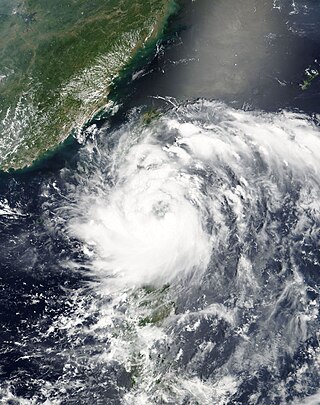
Tropical Storm Morakot, known in the Philippines as Tropical Storm Juaning, brought significant rainfall to Taiwan before alleviating drought conditions in mainland China in August 2003. The tenth named storm in the western Pacific that year, Morakot spawned from an area of disturbed weather in the Philippine Sea on July 31. Tracking northwest, favorable conditions allowed for the intensification of the system to tropical storm strength on August 2. Morakot reached peak intensity later that day with winds of 85 km/h (50 mph) and a minimum barometric pressure of 992 mbar. This intensity was held for several hours until less conducive atmospheric conditions slightly weakened the system; this was followed by Morakot making landfall on southern Taiwan on August 3. Subsequently, the storm weakened and moved into the Taiwan Strait before making its final landfall near Quanzhou, China the next day. The storm quickly weakened over the Chinese mainland, and dissipated entirely several hours after landfall.

Typhoon Fitow, known in the Philippines as Typhoon Quedan, was the strongest typhoon to make landfall in Mainland China during October since 1949. The 21st named storm of the 2013 Pacific typhoon season, Fitow developed on September 29 to the east of the Philippines. It initially tracked north-northwestward, gradually intensifying into a tropical storm and later to typhoon status, or with winds of at least 120 km/h (75 mph). Fitow later turned more to the west-northwest due to an intensifying ridge to the east, bringing the typhoon over the Ryukyu Islands with peak winds of 140 km/h (87 mph) on October 5. The next day, the typhoon struck China at Fuding in Fujian province. Fitow quickly weakened over land, dissipating on October 7.

Typhoon Abe, known as Typhoon Iliang in the Philippines, was the fourteenth named storm of 1990 Pacific typhoon season. Forming on August 23 from a tropical disturbance, the depression which would eventually develop into Typhoon Abe initially tracked in a steady west-northwestward direction. As a result of an intense monsoon surge, Abe's trajectory briefly changed to an eastward then northward path before returning to its original track. Abe only intensified by a small amount between 00:00 UTC August 24 and 06:00 UTC August 27 due to the disruptive effects of the surge, and on August 30, Abe peaked in intensity as a Category 2-equivalent typhoon on the Saffir–Simpson hurricane wind scale. After peaking in intensity, Abe crossed the Ryukyu Islands and the East China Sea, making landfall in China where it affected the provinces of Zhejiang and Jiangsu before entering the Yellow Sea, crossing South Korea, and finally transitioning into an extratropical cyclone.

Typhoon Soudelor, known in the Philippines as Super Typhoon Hanna, was the third most intense tropical cyclone worldwide in 2015 after Hurricane Patricia and Cyclone Pam as well as the strongest tropical cyclone of the 2015 Pacific typhoon season. Soudelor had severe impacts in the Northern Mariana Islands, Taiwan, and eastern China, resulting in 40 confirmed fatalities. Lesser effects were felt in Japan, South Korea and the Philippines. The thirteenth named storm of the annual typhoon season, Soudelor formed as a tropical depression near Pohnpei on July 29. The system strengthened slowly at first before entering a period of rapid intensification on August 2. Soudelor made landfall on Saipan later that day, causing extensive damage. Owing to favorable environmental conditions, the typhoon further deepened and reached its peak intensity with ten-minute maximum sustained winds of 215 km/h (130 mph) and a central atmospheric pressure of 900 hPa on August 3. The Joint Typhoon Warning Center assessed one-minute sustained winds at 285 km/h (180 mph), making Soudelor a Category 5-equivalent super typhoon. Steady weakening ensued thereafter as the storm moved generally west-northwest. Soudelor made landfall over Hualien, Taiwan, late on August 7 and emerged over in the Taiwan Strait early the next day. The typhoon soon moved inland over eastern China and degraded to a tropical depression by August 9.



